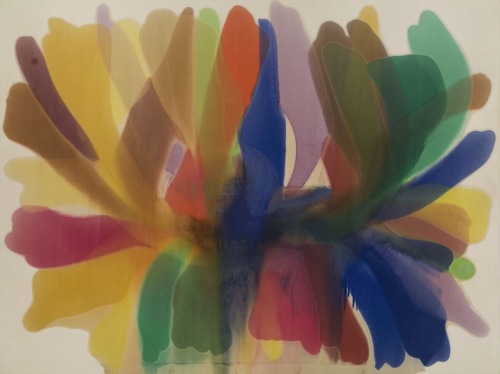#morris louis
Morris Louis - Beta Lambda (1961). Synthetic polymer paint on canvas.
“When Louis began making his large Unfurled paintings in 1960, their dimensions often made it impossible for him to extend the canvasses fully in his small studio—the dining room of his Washington, D.C., home. Similarly, few galleries were large enough to accommodate them, and only two of the more than one hundred in this series were exhibited before the artist died in 1962. Although Louis painted on a vast scale, the brightly colored ribbons of paint cascading down the sides of this canvas invite a close look. Perhaps even more remarkable than the immense size of this work is the broad expanse of raw canvas Louis left exposed—an emphatic void framed by exuberant color.” (MOMA)
Post link
Remembering Morris Louis, born on this day in 1912!
Louis was a central figure of the Washington Color School, a group of abstract painters that emerged in Washington, DC, in the late 1950s. Inspired by the techniques of Helen Frankenthaler, who used thinned pigments to “stain” her paintings, Louis devised a process of pouring diluted paint over the surfaces of unprimed and unstretched canvases. “Point of Tranquility,” from Louis’s Floral series, features flows of paint spreading outward from a dense center. The intense, sensual colors suggest dynamic processes of movement and growth.
Post link

Morris Louis
Untitled, 1959-1960
Magna on canvas, 98 in. × 140 ½ in.
Untitled exhibits trademark elements of the artist’s Floral series: broad bands of color that gravitate toward the center of the canvas and finer streaks of pigment that cascade to its base. Louis took cues from the visual vocabularies of fellow painters—including Jackson Pollock’s drips and Helen Frankenthaler’s washes—while also establishing his own distinctive style, seen here in the saturated fields of pooled, vibrant color. To achieve this effect, the artist thinned Magna with an acrylic resin and turpentine. He then poured the mixture onto an unprimed, loosely tacked canvas—a difficult undertaking, as the painting almost filled his tiny, twelve-by-fourteen-foot studio. Text from SFMoMa.



